Strategies to Reduce Crop Water Footprint in Intensive Wheat-Maize Rotations in North China Plain
Abstract
:1. Introduction
2. Materials and Methods
2.1. Study Site
2.2. Field Management and Experiment Data
2.3. Model Calibration and Evaluation
2.4. Systematic Exploration of Management Options of Irrigation and Nitrogen
2.5. Water Footprint Calculation Methods
2.6. Statistical Analysis
3. Results
3.1. Model Calibration and Evaluation
3.2. The Effect of Management on Water Footprint
3.2.1. The Impact of Winter Wheat N and Irrigation Management on the Water Footprint of Winter Wheat
3.2.2. The Impact of Winter Wheat Irrigation and N Management on the Water Footprint of Summer Maize
3.2.3. The Impact of Summer Maize Irrigation and N Management on the Water Footprint of Summer Maize
3.2.4. The Impact of Summer Maize Irrigation and N Levels on the Water Footprint of Winter Wheat
3.3. Managements Factors Influencing Average Water Footprint
4. Discussion
4.1. Evaluation of Methodology
4.2. The Effect of Managements on Water Footprint
4.3. Optimization of Fertilizer Strategies
5. Conclusions
Author Contributions
Funding
Institutional Review Board Statement
Informed Consent Statement
Data Availability Statement
Acknowledgments
Conflicts of Interest
References
- Wang, J.; Wang, E.L.; Yang, X.G.; Zhang, F.S.; Yin, H. Increased yield potential of wheat-maize cropping system in the North China Plain by climate change adaptation. Clim. Change 2012, 113, 825–840. [Google Scholar] [CrossRef]
- Carberry, P.S.; Liang, W.L.; Twomlow, S.; Holzworth, D.P.; Dimes, J.P.; McClelland, T.; Huth, N.I.; Chen, F.; Hochman, Z.; Keating, B.A. Scope for improved eco-efficiency varies among diverse cropping systems. Proc. Natl. Acad. Sci. USA 2013, 110, 8381–8386. [Google Scholar] [CrossRef] [PubMed] [Green Version]
- Chinese Statistical Bureau. China Statistical Yearbook; China Statistics Press: Beijing, China, 2016. [Google Scholar]
- Zhao, Z.G.; Qin, X.; Wang, E.L.; Carberry, P.; Zhang, Y.H.; Zhou, S.L.; Zhang, X.Y.; Hu, C.S.; Wang, Z.M. Modelling to increase the eco-efficiency of a wheat-maize double cropping system. Agric. Ecosyst. Environ. 2015, 210, 36–46. [Google Scholar] [CrossRef]
- Zhao, J.; Zhang, X.P.; Yang, Y.D.; Zang, H.D.; Yan, P.; Meki, M.N.; Doro, L.; Sui, P.; Jeong, J.; Zeng, Z.H. Alternative cropping systems for groundwater irrigation sustainability in the North China Plain. Agric. Water Manag. 2021, 250, 106867. [Google Scholar] [CrossRef]
- Xu, Y.J.; Huang, K.; Yu, Y.J.; Wang, X.M. Changes in water footprint of crop production in Beijing from 1978 to 2012: A logarithmic mean Divisia index decomposition analysis. J. Clean. Prod. 2015, 87, 180–187. [Google Scholar] [CrossRef]
- Darbyshire, R.; Crean, E.; Dunn, T.; Dunn, B. Predicting panicle initiation timing in rice grown using water efficient systems. Field Crops Res. 2019, 239, 159–164. [Google Scholar] [CrossRef]
- Zhai, Y.J.; Tan, X.F.; Ma, X.T.; An, M.G.; Zhao, Q.L.; Shen, X.X.; Hong, J.L. Water footprint analysis of wheat production. Ecol. Indic. 2019, 102, 95–102. [Google Scholar] [CrossRef]
- Sun, Y.Y.; Zhi, Y.; Zhao, Y.W. Indirect effects of carbon taxes on water conservation: A water footprint analysis for China. J. Environ. Manag. 2021, 279, 111747. [Google Scholar] [CrossRef]
- Hoekstra, A.Y.; Chapagain, A.K.; Aldaya, M.M.; Mekonnen, M.M. The Water Footprint Assessment Manual: Setting the Global Standard; Earthscan: London, UK, 2011. [Google Scholar]
- Chapagain, A.K.; Hoekstra, A.Y.; Savenije, H.H.G.; Gautam, R. The water footprint of cotton consumption: An assessment of the impact of worldwide consumption of cotton products on the water resources in the cotton producing countries. Ecol. Econ. 2006, 60, 186–203. [Google Scholar] [CrossRef]
- Chapagain, A.K.; Orr, S. An improved water footprint methodology linking global consumption to local water resources: A case of Spanish tomatoes. J. Environ. Manag. 2009, 90, 1219–1228. [Google Scholar] [CrossRef]
- Morillo, J.G.; Diaz, J.A.R.; Camacho, E.; Montesinos, P. Linking water footprint accounting with irrigation management in high value crops. J. Clean. Prod. 2015, 87, 594–602. [Google Scholar] [CrossRef]
- Scarpare, F.V.; Hernandes, T.A.D.; Ruiz-Correa, S.T.; Kolln, O.T.; Gava, G.J.D.C.; Santos, L.N.S.D.; Victoria, R.L. Sugarcane water footprint under different management practices in Brazil: Tiete/Jacare watershed assessment. J. Clean. Prod. 2016, 112, 4576–4584. [Google Scholar] [CrossRef]
- Bocchiola, D.; Nana, E.; Soncini, A. Impact of climate change scenarios on crop yield and water footprint of maize in the Po valley of Italy. Agric. Water Manag. 2013, 116, 50–61. [Google Scholar] [CrossRef]
- Pellegrini, G.; Ingrao, C.; Carnposeo, S.; Tricase, C.; Conto, F.; Huisingh, D. Application of water footprint to olive growing systems in the Apulia region: A comparative assessment. J. Clean. Prod. 2016, 112, 2407–2418. [Google Scholar] [CrossRef]
- Zhuo, L.; Mekonnen, M.M.; Hoekstra, A.Y. Benchmark levels for the consumptive water footprint of crop production for different environmental conditions: A case study for winter wheat in China. Hydrol. Earth Syst. Sc. 2016, 20, 4547–4559. [Google Scholar] [CrossRef] [Green Version]
- Finogenova, N.; Dolganova, I.; Berger, M.; Nunez, M.; Blizniukova, D.; Mueller-Frank, A.; Finkbeiner, M. Water footprint of German agricultural imports: Local impacts due to global trade flows in a fifteen-year perspective. Sci. Total Environ. 2019, 662, 521–529. [Google Scholar] [CrossRef]
- Gleeson, T.; Wada, Y.; Bierkens, M.F.P.; van Beek, L.P.H. Water balance of global aquifers revealed by groundwater footprint. Nature 2012, 488, 197–200. [Google Scholar] [CrossRef]
- Hoekstra, A.Y.; Mekonnen, M.M. The water footprint of humanity. Proc. Natl. Acad. Sci. USA 2012, 109, 3232–3237. [Google Scholar] [CrossRef] [Green Version]
- Zhao, X.; Liao, X.W.; Chen, B.; Tillotson, M.R.; Guo, W.; Li, Y.P. Accounting global grey water footprint from both consumption and production perspectives. J. Clean. Prod. 2019, 225, 963–971. [Google Scholar] [CrossRef]
- Mekonnen, M.M.; Hoekstra, A.Y. Water footprint benchmarks for crop production: A first global assessment. Ecol. Indic. 2014, 46, 214–223. [Google Scholar] [CrossRef] [Green Version]
- Chukalla, A.D.; Krol, M.S.; Hoekstra, A.Y. Green and blue water footprint reduction in irrigated agriculture: Effect of irrigation techniques, irrigation strategies and mulching. Hydrol. Earth Syst. Sc. 2015, 19, 4877–4891. [Google Scholar] [CrossRef] [Green Version]
- Brueck, H.; Lammel, J. Impact of fertilizer N application on the grey water footprint of winter wheat in a NW-European temperate climate. Water 2016, 8, 356. [Google Scholar] [CrossRef]
- Muratoglu, A. Grey water footprint of agricultural production: An assessment based on nitrogen surplus and high-resolution leaching runoff fractions in Turkey. Sci. Total Environ. 2020, 742, 140553. [Google Scholar] [CrossRef] [PubMed]
- Zeng, Z.; Liu, J.; Koeneman, P.H.; Zarate, E.; Hoekstra, A.Y. Assessing water footprint at river basin level: A case study for the Heihe River Basin in Northwest China. Hydrol. Earth Syst. Sc. 2012, 16, 2771–2781. [Google Scholar] [CrossRef] [Green Version]
- Mekonnen, M.M.; Hoekstra, A.Y. The green, blue and grey water footprint of crops and derived crop products. Hydrol. Earth Syst. Sc. 2011, 15, 1577–1600. [Google Scholar] [CrossRef] [Green Version]
- Zhang, Z.Y.; Yang, H.; Shi, M.J. Analyses of water footprint of Beijing in an interregional input-output framework. Ecol. Econ. 2011, 70, 2494–2502. [Google Scholar] [CrossRef]
- Zhang, C.; Anadon, L.D. A multi-regional input-output analysis of domestic virtual water trade and provincial water footprint in China. Ecol. Econ. 2014, 100, 159–172. [Google Scholar] [CrossRef]
- Hoogenboom, G.; Jones, J.W.; Wilkens, P.W.; Porter, C.H.; Boote, K.J.; Hunt, L.D.; Singh, U.; Lizaso, J.I.; White, J.M.; Uryasev, O. Decision Support System for Agrotechnology Transfer (DSSAT) Version 4.6; DSSAT Foundation: Prosser, WA, USA, 2015. [Google Scholar]
- Batchelor, W.D.; Basso, B.; Paz, J.O. Examples of strategies to analyze spatial and temporal yield variability using crop models. Eur. J. Agron. 2002, 18, 141–158. [Google Scholar] [CrossRef]
- Li, Y.C.; Huang, H.P.; Ju, H.; Lin, E.D.; Xiong, W.; Han, X.; Wang, H.R.; Peng, Z.P.; Wang, Y.Q.; Xu, J.W.; et al. Assessing vulnerability and adaptive capacity to potential drought for winter-wheat under the RCP 8.5 scenario in the Huang-Huai-Hai Plain. Agric. Ecosyst. Environ. 2015, 209, 125–131. [Google Scholar] [CrossRef]
- Awan, Z.A.; Khaliq, T.; Akhtar, M.M.; Imran, A.; Irfan, M.; Ahmed, M.J.; Ahmad, A. Building climate-resilient cotton production system for changing climate scenarios using the DSSAT model. Sustainability 2021, 13, 10495. [Google Scholar] [CrossRef]
- Jiang, Y.W.; Zhang, L.H.; Zhang, B.Q.; He, C.S.; Jin, X.; Bai, X. Modeling irrigation management for water conservation by DSSAT-maize model in arid northwestern China. Agric. Water Manag. 2016, 177, 37–45. [Google Scholar] [CrossRef]
- Xiang, Z.; Bailey, R.T.; Nozari, S.; Husain, Z.; Kisekka, I.; Sharda, V.; Gowda, P. DSSAT-MODFLOW: A new modeling framework for exploring groundwater conservation strategies in irrigated areas. Agr. Water Manag. 2020, 232, 103033. [Google Scholar] [CrossRef]
- Si, Z.Y.; Zain, M.; Li, S.; Liu, J.M.; Liang, Y.P.; Gao, Y.; Duan, A.W. Optimizing nitrogen application for drip-irrigated winter wheat using the DSSAT-CERES-Wheat model. Agr. Water Manag. 2021, 244, 106592. [Google Scholar] [CrossRef]
- Ren, X.M.; Sun, D.B.; Wang, Q.S. Modeling the effects of plant density on maize productivity and water balance in the Loess Plateau of China. Agric. Water Manag. 2016, 171, 40–48. [Google Scholar] [CrossRef]
- Zhang, D.; Wang, H.G.; Li, D.X.; Li, H.R.; Ju, H.; Li, R.Q.; Batchelor, W.D.; Li, Y.M. DSSAT-CERES-wheat model to optimize plant density and nitrogen best management practices. Nutr. Cycl. Agroecosys. 2019, 114, 19–32. [Google Scholar] [CrossRef]
- Li, Z.T.; Yang, J.Y.; Drury, C.F.; Hoogenboom, G. Evaluation of the DSSAT-CSM for simulating yield and soil organic C and N of a long-term maize and wheat rotation experiment in the Loess Plateau of Northwestern China. Agric. Syst. 2015, 135, 90–104. [Google Scholar] [CrossRef]
- Araya, A.; Kisekka, I.; Gowda, P.H.; Prasad, P.V.V. Evaluation of water-limited cropping systems in a semi-arid climate using DSSAT-CSM. Agric. Syst. 2017, 150, 86–98. [Google Scholar] [CrossRef] [Green Version]
- Ventrella, D.; Giglio, L.; Charfeddine, M.; Dalla Marta, A. Consumptive use of green and blue water for winter durum wheat cultivated in Southern Italy. Ital. J. Agrometeorol. 2015, 20, 33–44. [Google Scholar]
- Yesilköy, S.; Saylan, L. Yields and water footprints of sunflower and winter wheat under different climate projections. J. Clean. Prod. 2021, 2, 126780. [Google Scholar] [CrossRef]
- Lv, L.H.; Dong, Z.Q.; Zhang, J.T.; Zhang, L.H.; Liang, S.B.; Jia, X.L.; Yao, H.P. Effect of water and nitrogen on yield and nitrogen utilization of winter wheat and summer maize. Sci. Agri. Sin. 2014, 47, 3839–3849. [Google Scholar]
- Zhang, J.T.; Chen, Q.Y.; Lv, L.H.; Shen, H.P.; Jia, X.L.; Liang, S.P. Optimum combination of irrigation and nitrogen for high yield and nitrogen use efficiency in winter wheat and summer maize rotation system. J. Plant Nutr. Fert. 2016, 22, 886–896. [Google Scholar] [CrossRef]
- Jones, J.W.; Hoogenboom, G.; Porter, C.H.; Boote, K.J.; Batchelor, W.D.; Hunt, L.A.; Wilkens, P.W.; Singh, U.; Gijsman, A.J.; Ritchie, J.T. The DSSAT cropping system model. Eur. J. Agron. 2003, 18, 235–265. [Google Scholar] [CrossRef]
- Yang, Y.H.; Watanabe, M.; Zhang, X.Y.; Zhang, J.Q.; Wang, Q.X.; Hayashi, S. Optimizing irrigation management for wheat to reduce groundwater depletion in the piedmont region of the Taihang Mountains in the North China Plain. Agric. Water Manag. 2006, 82, 25–44. [Google Scholar] [CrossRef]
- Chen, C.; Wang, E.L.; Yu, Q. Modeling wheat and maize productivity as affected by climate variation and irrigation supply in North China Plain. Agron. J. 2010, 102, 1037–1049. [Google Scholar] [CrossRef] [Green Version]
- Willmott, C.J. Some Comments on the Evaluation of Model Performance. Bull. Am. Meteorol. Soc. 1982, 63, 1309–1313. [Google Scholar] [CrossRef] [Green Version]
- Yang, J.; Greenwood, D.J.; Rowell, D.L.; Wadsworth, G.A.; Burns, I.G. Statistical methods for evaluating a crop nitrogen simulation model, N_ABLE. Agric. Syst. 2000, 64, 37–53. [Google Scholar] [CrossRef]
- Jamieson, P.D.; Porter, J.R.; Wilson, D.R. A test of the computer-simulation model Archwheat1 on wheat crops grown in New-Zealand. Field Crops Res. 1991, 27, 337–350. [Google Scholar] [CrossRef]
- De Mendiburu, F. Agricolae: Statistical Procedures for Agricultural Research; R Team: Vienna, Austria, 2012; Volume 1, pp. 2–4. [Google Scholar]
- Rosseel, Y. Lavaan: An R Package for Structural Equation Modeling. J. Stat. Softw. 2012, 48, 1–36. [Google Scholar] [CrossRef] [Green Version]
- Lu, Y.; Zhang, X.Y.; Chen, S.Y.; Shao, L.W.; Sun, H.Y. Changes in water use efficiency and water footprint in grain production over the past 35 years: A case study in the North China Plain. J. Clean. Prod. 2016, 116, 71–79. [Google Scholar] [CrossRef]
- Liu, X.J.; Zhang, Y.; Han, W.X.; Tang, A.H.; Shen, J.L.; Cui, Z.L.; Vitousek, P.; Erisman, J.W.; Goulding, K.; Christie, P.; et al. Enhanced nitrogen deposition over China. Nature 2013, 494, 459–462. [Google Scholar] [CrossRef]
- Lu, J.; Hu, T.; Geng, C.; Cui, X.; Fan, J.; Zhang, F. Response of yield, yield components and water-nitrogen use efficiency of winter wheat to different drip fertigation regimes in Northwest China. Agri. Water Manag. 2021, 255, 107034. [Google Scholar] [CrossRef]
- Feng, H.; Sun, F.; Liu, Y.; Zeng, P.; Che, Y. Mapping multiple water pollutants across china using the grey water footprint. Sci. Total Environ. 2021, 785, 147255. [Google Scholar] [CrossRef]
- Lu, J.; Hu, T.; Zhang, B.; Wang, L.; Yang, S.H.; Fan, J.L.; Yan, S.C.; Zhang, F. Nitrogen fertilizer management effects on soil nitrate leaching, grain yield and economic benefit of summer maize in Northwest China. Agri. Water Manag. 2021, 247, 106739. [Google Scholar] [CrossRef]
- Li, X.X.; Hu, C.S.; Delgado, J.A.; Zhang, Y.M.; Ouyang, Z.Y. Increased nitrogen use efficiencies as a key mitigation alternative to reduce nitrate leaching in North China Plain. Agric. Water Manag. 2007, 89, 137–147. [Google Scholar] [CrossRef]
- Wang, S.Q.; Wei, S.C.; Liang, H.Y.; Zheng, W.B.; Li, X.X.; Hu, C.S.; Currell, M.J.; Zhou, F.; Min, L.L. Nitrogen stock and leaching rates in a thick vadose zone below areas of long-term nitrogen fertilizer application in the North China Plain: A future groundwater quality threat. J. Hydrol. 2019, 576, 28–40. [Google Scholar] [CrossRef]
- Lu, Y.; Wang, E.L.; Zhao, Z.; Liu, X.W.; Tian, A.L.; Zhang, X.Y. Optimizing irrigation to reduce N leaching and maintain high crop productivity through the manipulation of soil water storage under summer monsoon climate. Field Crops Res. 2021, 265, 108110. [Google Scholar] [CrossRef]
- Li, Y.; Liu, H.J.; Huang, G.H. The effect of nitrogen rates on yields and nitrogen use efficiencies during four years of wheat-maize rotation cropping seasons. Agron. J. 2016, 108, 2076–2088. [Google Scholar] [CrossRef]
- Li, Y.; Liu, H.J.; Huang, G.H.; Zhang, R.H.; Yang, H.Y. Nitrate nitrogen accumulation and leaching pattern at a winter wheat: Summer maize cropping field in the North China Plain. Environ. Earth. Sci. 2016, 75, 118. [Google Scholar] [CrossRef]
- Chen, C.; Wang, E.L.; Yu, Q.A. Modelling the effects of climate variability and water management on crop water productivity and water balance in the North China Plain. Agric. Water Manag. 2010, 97, 1175–1184. [Google Scholar] [CrossRef]
- Ma, Y.; Feng, S.Y.; Song, X.F. A root zone model for estimating soil water balance and crop yield responses to deficit irrigation in the North China Plain. Agric. Water Manag. 2013, 127, 13–24. [Google Scholar] [CrossRef]
- Pei, H.W.; Shen, Y.J.; Liu, C.M. Nitrogen and water cycling of typical cropland in the North China Plain. Chin. J. Appl. Ecol. 2015, 26, 283–296. [Google Scholar] [CrossRef]
- Gu, L.M.; Liu, T.N.; Wang, J.F.; Liu, P.; Dong, S.T.; Zhao, B.Q.; So, H.B.; Zhang, J.W.; Zhao, B. Lysimeter study of nitrogen losses and nitrogen use efficiency of Northern Chinese wheat. Field Crops Res. 2016, 188, 82–95. [Google Scholar] [CrossRef]
- Sun, H.Y.; Zhang, X.Y.; Wang, E.L.; Chen, S.Y.; Shao, L.W. Quantifying the impact of irrigation on groundwater reserve and crop production-A case study in the North China Plain. Eur. J. Agron. 2015, 70, 48–56. [Google Scholar] [CrossRef]
- Wu, Y.C.; Zhou, S.L.; Wang, Z.M.; Feng, H.Y.; Lu, L.Q.; Wang, R.Z. Recovery of residual fertilizer-nitrogen by wheat in a winter wheat-summer maize rotation in the North China Plain: A soil column study. Agron. J. 2009, 101, 925–932. [Google Scholar] [CrossRef]
- Kadiyala, M.D.M.; Jones, J.W.; Mylavarapu, R.S.; Li, Y.C.; Reddy, M.D. Identifying irrigation and nitrogen best management practices for aerobic rice-maize cropping system for semi-arid tropics using CERES-rice and maize models. Agric. Water Manag. 2015, 149, 23–32. [Google Scholar] [CrossRef] [Green Version]
- Liu, L.; Yao, S.; Zhang, H.; Muhammed, A.; Xu, J.; Li, R.; Zhang, D.; Zhang, S.; Yang, X. Soil nitrate nitrogen buffer capacity and environmentally safe nitrogen rate for winter wheat-summer maize cropping in Northern China. Agric. Water Manag. 2019, 213, 445–453. [Google Scholar] [CrossRef]
- Peng, Y.; Yu, P.; Li, X.; Li, C. Determination of the critical soil mineral nitrogen concentration for maximizing maize grain yield. Plant Soil 2013, 372, 41–51. [Google Scholar] [CrossRef]
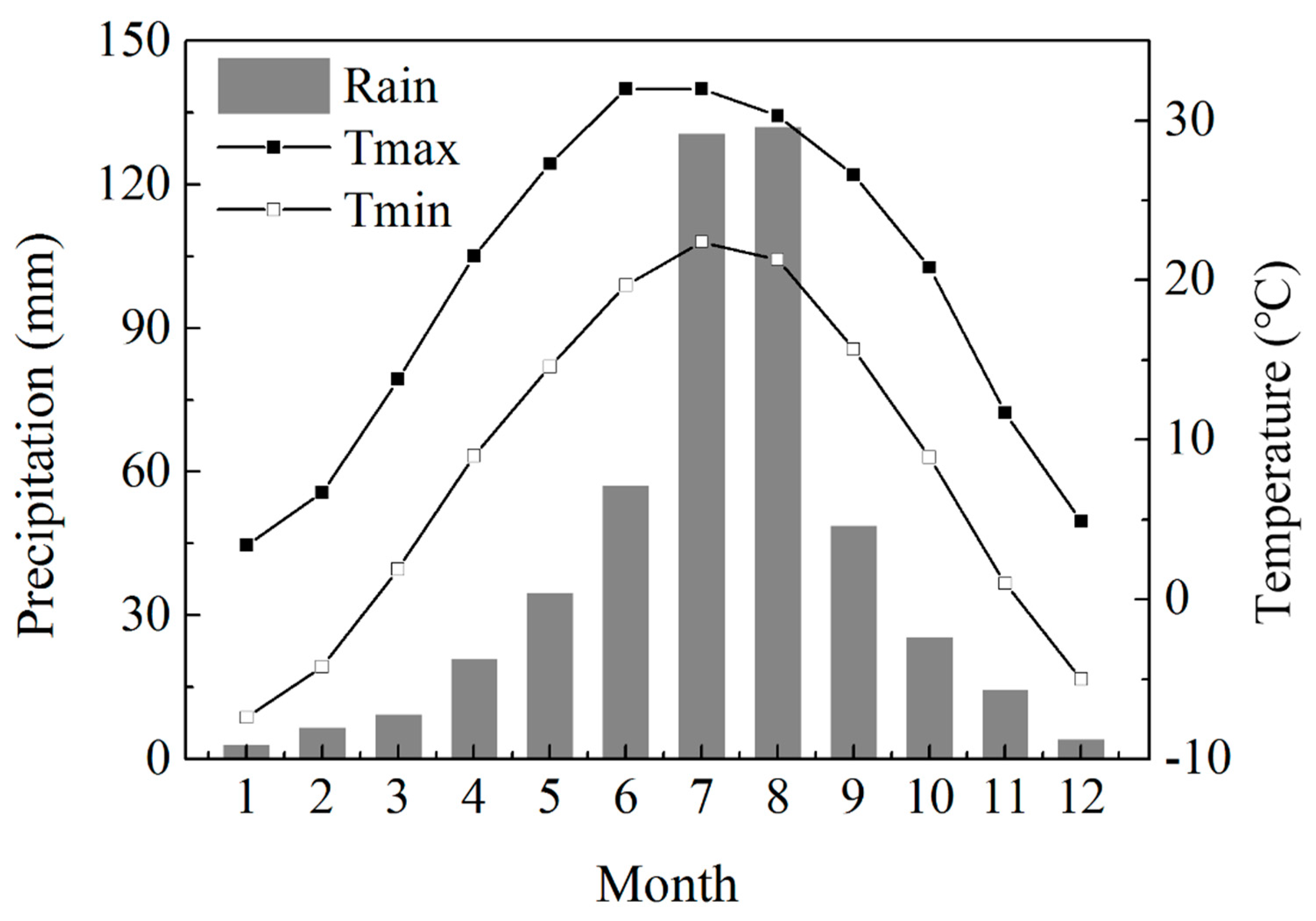
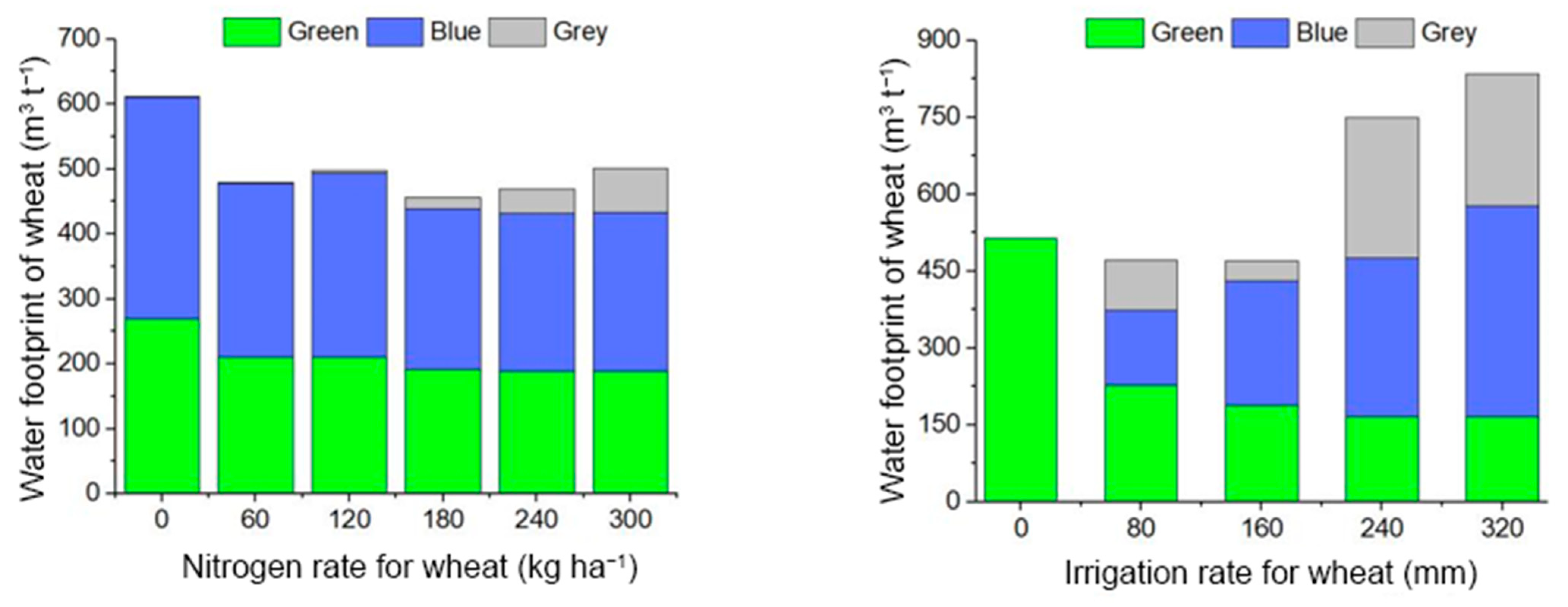
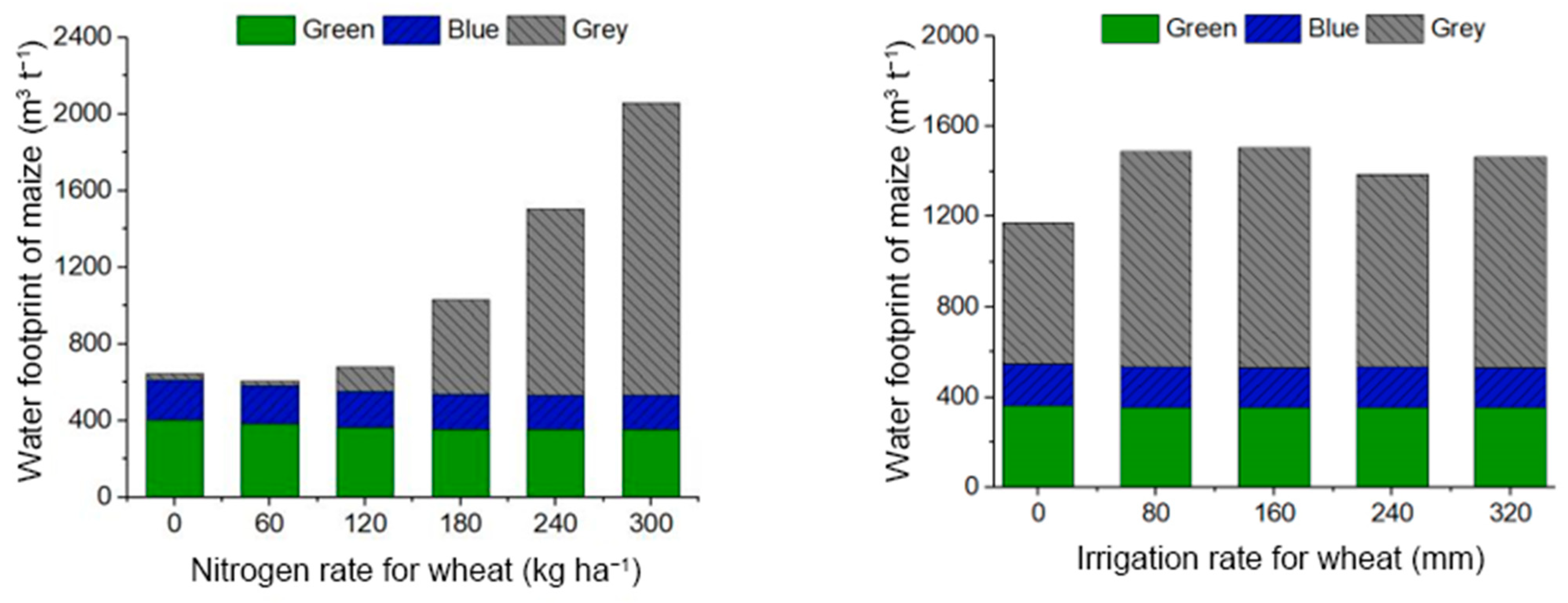
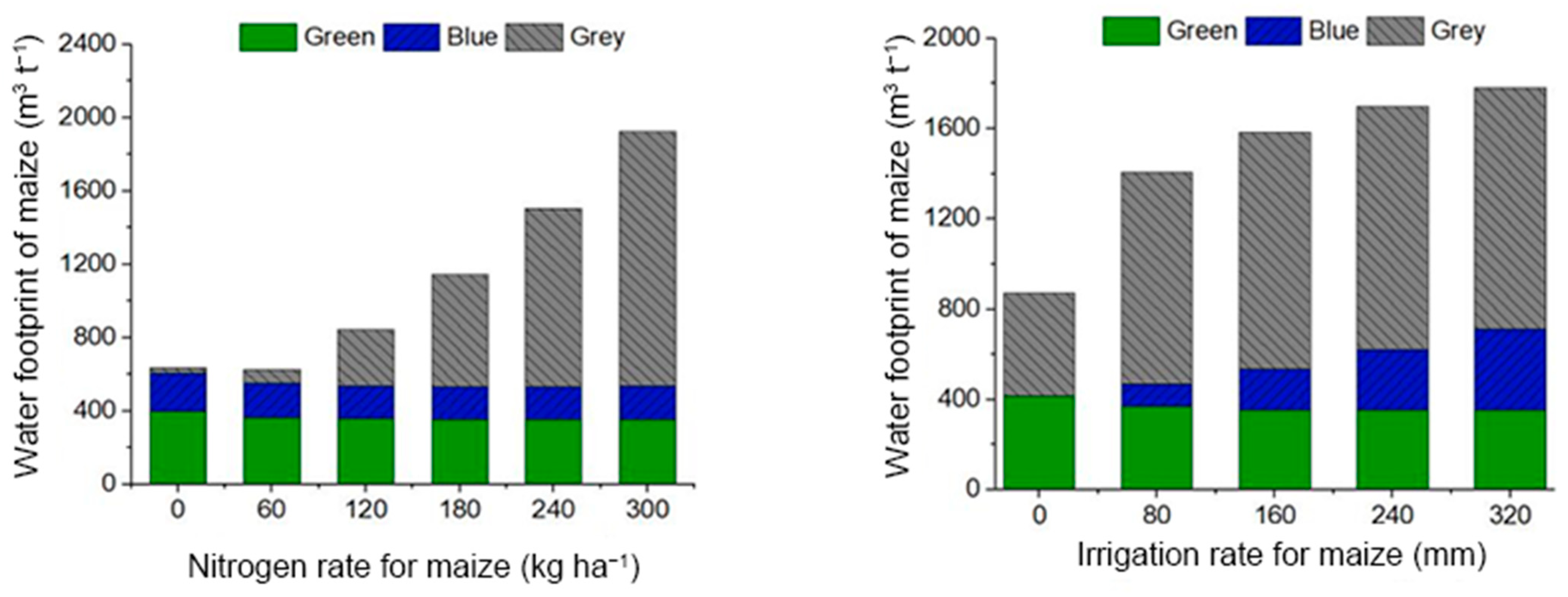
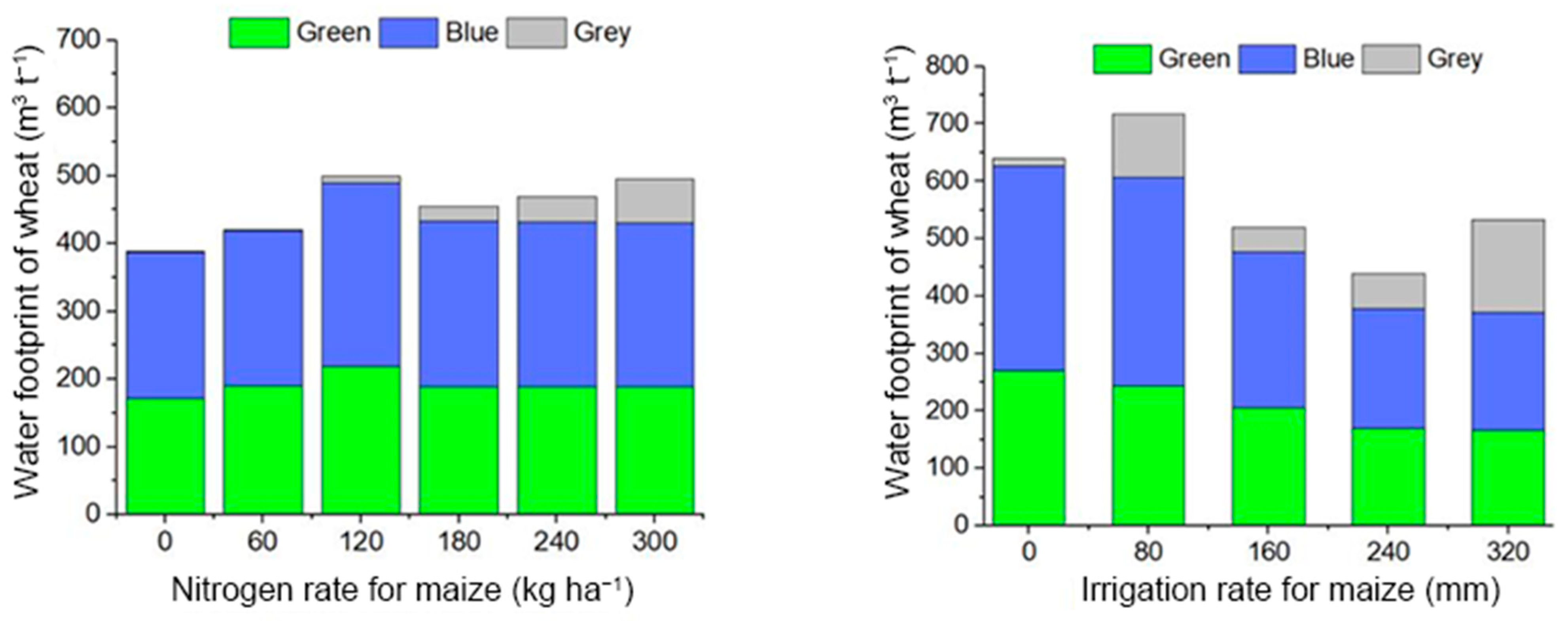
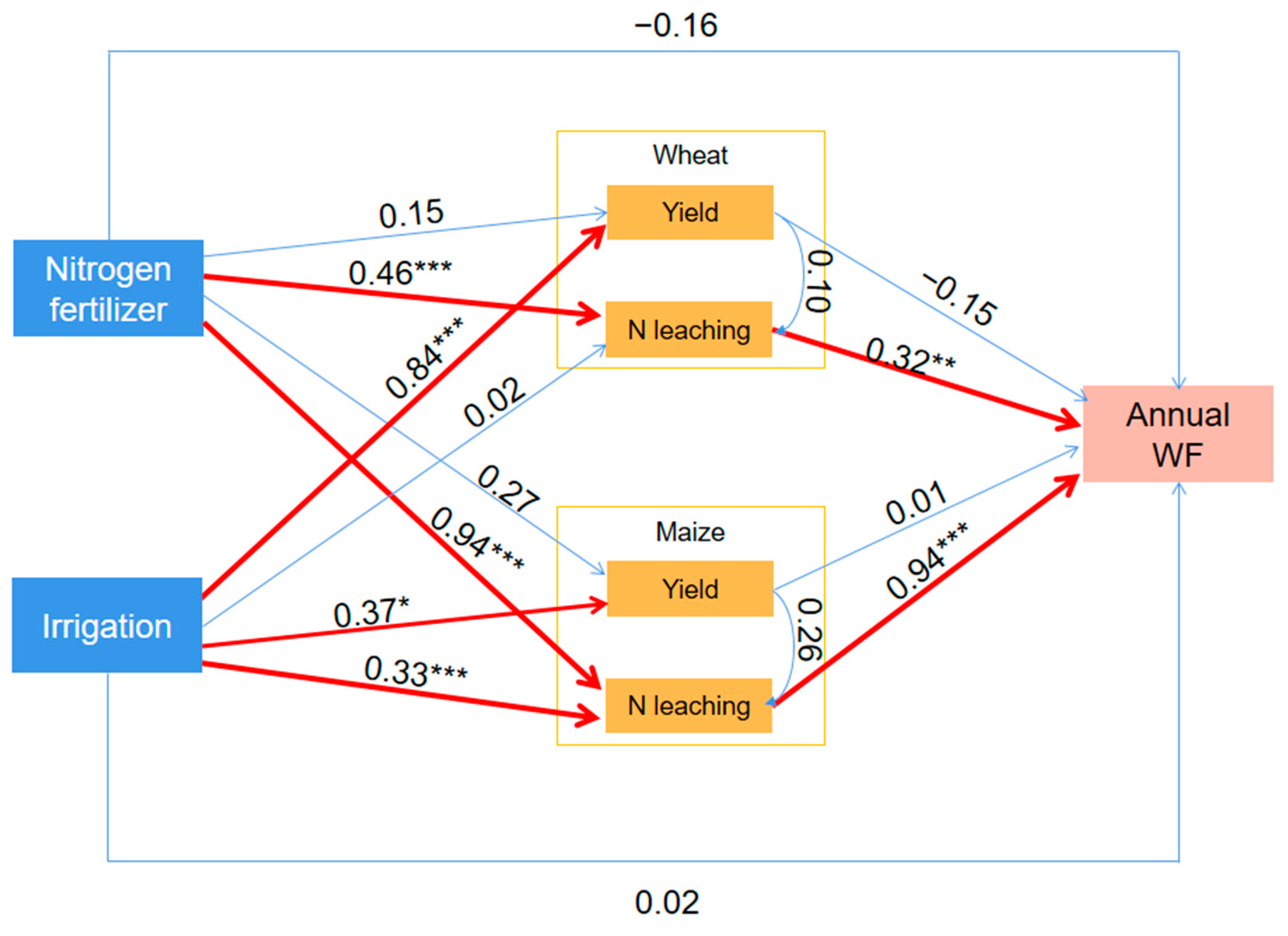
| Cultivar Coefficient | Definition | Calibrated Value |
|---|---|---|
| P1V | Days, optimum vernalizing temperature, required for vernalization | 45 |
| P1D | Photoperiod response (% reduction in rate 10 h−1 drop in photoperiod) | 70 |
| P5 | Grain filling (excluding lag) phase duration (°C day) | 720 |
| G1 | Kernel number per unit canopy weight at anthesis (g) | 30 |
| G2 | Standard kernel size under optimum conditions (mg) | 29 |
| G3 | Standard, non-stressed mature tiller wt (including grain, g dry weight) | 1.0 |
| PHINT | Interval between successive leaf tip appearances (°C day) | 90 |
| Cultivar Coefficient | Definition | Calibrated Value |
|---|---|---|
| P1 | Degree days (base 8 °C) from emergence to end of juvenile phase | 260.0 |
| P2 | Photoperiod sensitivity coefficient (0–1.0) | 0.3 |
| P5 | Thermal time from silking to physiological maturity | 870.0 |
| G2 | Maximum potential number of kernels per plant | 820.0 |
| G3 | Kernel filling rate during the linear grain filling stage and under optimum conditions (mg day−1) | 9.0 |
| PHINT | Interval between successive leaf tip appearances (°C day) | 38.9 |
| Scenario | Wheat | Maize | ||
|---|---|---|---|---|
| Irrigation (mm) | Nitrogen (kg ha−1) | Irrigation (mm) | Nitrogen (kg ha−1) | |
| 1 | 0, 80, 160, 240, 320 | 240 | 160 | 240 |
| 2 | 160 | 0, 60, 120, 180, 240, 300 | 160 | 240 |
| 3 | 160 | 240 | 0, 80, 160, 240, 320 | 240 |
| 4 | 160 | 240 | 160 | 0, 60, 120, 180, 240, 300 |
| Treatment | Winter Wheat | Summer Maize | ||||||||||
|---|---|---|---|---|---|---|---|---|---|---|---|---|
| n | Observed t ha−1 | Simulated t ha−1 | ME t ha−1 | nRMSE % | d | n | Observed t ha−1 | Simulated t ha−1 | ME t ha−1 | nRMSE % | d | |
| Limited Irrigation | ||||||||||||
| N180 | 7 | 6.995 | 6.284 | −0.711 | 12.55 | 0.86 | 7 | 9.088 | 8.957 | −0.131 | 11.09 | 0.71 |
| N240 | 7 | 6.919 | 7.433 | 0.514 | 12.90 | 0.70 | 7 | 8.947 | 9.083 | 0.136 | 9.56 | 0.83 |
| N300 | 7 | 6.926 | 7.305 | 0.379 | 12.19 | 0.73 | 7 | 8.748 | 9.097 | 0.350 | 8.49 | 0.84 |
| Total | 21 | 6.947 | 7.007 | 0.060 | 12.55 | 0.99 | 21 | 8.928 | 9.046 | 0.118 | 9.80 | 1.00 |
| Full Irrigation | ||||||||||||
| N180 | 7 | 8.069 | 8.004 | −0.065 | 5.84 | 0.93 | 7 | 9.475 | 8.610 | −0.865 | 9.82 | 0.73 |
| N240 | 7 | 7.904 | 8.101 | 0.196 | 8.70 | 0.85 | 7 | 9.341 | 9.108 | −0.233 | 6.14 | 0.82 |
| N300 | 7 | 8.074 | 8.101 | 0.027 | 8.27 | 0.84 | 7 | 9.146 | 9.107 | −0.039 | 9.54 | 0.72 |
| Total | 21 | 8.016 | 8.068 | 0.053 | 7.69 | 0.87 | 21 | 9.321 | 8.942 | −0.379 | 8.66 | 1.00 |
| Nitrogen | Irrigation | Wheat | Maize | |||||
|---|---|---|---|---|---|---|---|---|
| Yield | ET | N Leaching | Yield | ET | N Leaching | |||
| Wheat yield | 0.29 | 0.86 *** | 1.00 | |||||
| Wheat ET | 0.16 | 0.91 *** | 0.96 *** | 1.00 | ||||
| Wheat N leaching | 0.62 *** | 0.03 | 0.27 | 0.19 | 1.00 | |||
| Maize yield | 0.43 ** | 0.55 *** | 0.56 *** | 0.49 ** | 0.06 | 1.00 | ||
| Maize ET | 0.20 | 0.79 *** | 0.67 *** | 0.66 *** | −0.09 | 0.85 *** | 1.00 | |
| Maize N Leaching | 0.90 *** | 0.29 | 0.45 ** | 0.33 * | 0.50 ** | 0.68 *** | 0.50 ** | 1.00 |
| Total WF | 0.90 *** | 0.18 | 0.35 * | 0.21 | 0.65 *** | 0.49 ** | 0.30 | 0.90 *** |
| No | Wheat | Maize | Rs | ||||||||||||||
|---|---|---|---|---|---|---|---|---|---|---|---|---|---|---|---|---|---|
| Yield | CV | WF | Return | Yield | CV | WF | Return | ||||||||||
| t ha−1 | R | % | R | m3 t−1 | R | $ ha−1 | R | t ha−1 | R | % | R | m3 t−1 | R | $ ha−1 | R | ||
| 1 | 4.85 | 9 | 30.42 | 7 | 670.2 | 8 | 1084.5 | 9 | 6.22 | 9 | 16.60 | 1 | 764.8 | 6 | 1843.9 | 9 | 58 |
| 2 | 4.93 | 8 | 32.33 | 8 | 659.8 | 7 | 1121.8 | 8 | 7.31 | 8 | 19.11 | 2 | 699.3 | 4 | 2184.2 | 8 | 53 |
| 3 | 5.51 | 7 | 33.40 | 9 | 604.0 | 5 | 1330.6 | 7 | 8.00 | 6 | 22.03 | 6 | 683.6 | 3 | 2379.5 | 6 | 49 |
| 4 | 5.81 | 6 | 25.50 | 1 | 525.2 | 3 | 1385.9 | 6 | 7.40 | 7 | 22.51 | 9 | 726.3 | 5 | 2270.8 | 7 | 44 |
| 5 | 6.03 | 5 | 28.14 | 5 | 520.9 | 2 | 1466.0 | 5 | 8.23 | 5 | 21.59 | 4 | 662.3 | 2 | 2514.4 | 5 | 33 |
| 6 | 6.45 | 3 | 28.48 | 6 | 579.5 | 4 | 1616.9 | 3 | 8.45 | 3 | 22.42 | 8 | 800.0 | 7 | 2542.6 | 4 | 38 |
| 7 | 6.20 | 4 | 27.77 | 4 | 515.1 | 1 | 1471.6 | 4 | 8.42 | 4 | 21.43 | 3 | 655.4 | 1 | 2637.0 | 1 | 22 |
| 8 | 6.63 | 2 | 26.79 | 3 | 615.3 | 6 | 1626.1 | 2 | 8.53 | 1 | 21.96 | 5 | 873.4 | 8 | 2622.6 | 2 | 29 |
| 9 | 6.83 | 1 | 25.73 | 2 | 795.9 | 9 | 1699.0 | 1 | 8.49 | 2 | 22.31 | 7 | 1253.5 | 9 | 2556.4 | 3 | 34 |
Publisher’s Note: MDPI stays neutral with regard to jurisdictional claims in published maps and institutional affiliations. |
© 2022 by the authors. Licensee MDPI, Basel, Switzerland. This article is an open access article distributed under the terms and conditions of the Creative Commons Attribution (CC BY) license (https://creativecommons.org/licenses/by/4.0/).
Share and Cite
Zhang, D.; Li, D.; Li, H.; Wang, H.; Liu, J.; Ju, H.; Batchelor, W.D.; Li, R.; Li, Y. Strategies to Reduce Crop Water Footprint in Intensive Wheat-Maize Rotations in North China Plain. Agronomy 2022, 12, 357. https://doi.org/10.3390/agronomy12020357
Zhang D, Li D, Li H, Wang H, Liu J, Ju H, Batchelor WD, Li R, Li Y. Strategies to Reduce Crop Water Footprint in Intensive Wheat-Maize Rotations in North China Plain. Agronomy. 2022; 12(2):357. https://doi.org/10.3390/agronomy12020357
Chicago/Turabian StyleZhang, Di, Dongxiao Li, Haoran Li, Hongguang Wang, Jinna Liu, Hui Ju, William D. Batchelor, Ruiqi Li, and Yanming Li. 2022. "Strategies to Reduce Crop Water Footprint in Intensive Wheat-Maize Rotations in North China Plain" Agronomy 12, no. 2: 357. https://doi.org/10.3390/agronomy12020357
APA StyleZhang, D., Li, D., Li, H., Wang, H., Liu, J., Ju, H., Batchelor, W. D., Li, R., & Li, Y. (2022). Strategies to Reduce Crop Water Footprint in Intensive Wheat-Maize Rotations in North China Plain. Agronomy, 12(2), 357. https://doi.org/10.3390/agronomy12020357






